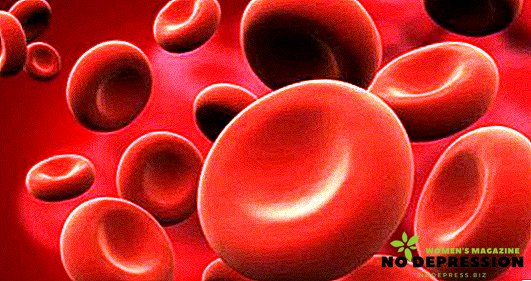Red blood cells are blood cells that perform important functions in the human body. In some cases, there are too many of them, and this condition may indicate serious health problems.

The increase in red blood cells in the body is not a rare occurrence in medical practice and is called erythrocytosis.
Elevated red blood cells - what does this mean?
In humans, red blood cells are responsible for transporting oxygen and carbon dioxide. Red blood corpuscles have a peculiar biconcave shape, they successfully regulate oxygen exchange and adsorption of harmful substances.
Red blood cells protect the human body from toxic elements and cleanse the decay products. Thanks to them, it is possible to normalize the respiration of tissues, to ensure the acid balance and alkaline balance of the blood.
The concentration of red blood cells depends on gender, age and individual characteristics of the organism. In women, the rate is 3.4-5.1 * 1012 / l, in men - 4.1-5.7 * 1012 / l, and in children the rate reaches 4-6.6 * 1012 / l. To conduct an initial diagnosis and identify the condition of the body is possible with the help of a routine blood test.
An increased concentration of red blood cells may indicate dehydration or other serious pathologies that are dangerous to human health.
Main reasons
 When erythrocytosis, the blood becomes quite viscous and thick, which disrupts its normal movement through the capillaries.
When erythrocytosis, the blood becomes quite viscous and thick, which disrupts its normal movement through the capillaries.
In the body, red blood cell production can increase if there is a shortage of oxygen.
This usually occurs with congenital heart defects, chronic obstructive pulmonary disease, hemoglobinopathy and heart failure.
The man
Often, the level of red blood cells in a man's body rises under the influence of certain physiological factors:
- increased physical and mental stress on the body;
- frequent stress and emotional distress;
- the effects of various toxins and toxic substances.
In addition, an elevated level of red blood cells is observed in men living in highlands, and this condition is considered normal. In this situation, no treatment is carried out, and when moving to flat terrain, all indicators are normalized.
Often, erythrocytosis in men develops with dehydration, which occurs for natural reasons or as a result of diarrhea, vomiting, or fever.
In some situations, the red blood cells in the male body increase in kidney pathologies, in which the body begins to produce too many red blood cells. Mostly this is observed in some malignant tumors or after kidney transplantation surgery.
There are situations when the growth of red blood cells in the male body is observed in the pathologies of the bone marrow. Among such diseases, true polycythemia and diseases of the hematopoietic system occurring in chronic form are considered the most common.
In addition, myeloproliferative diseases, which produce too many red blood cells, platelets and leukocytes in the bone marrow, can cause the growth of red blood cells.
The woman
 High levels of red blood cells in women may indicate progression in the body of the same pathologies as in men. At the same time, there are some differences in this plan.
High levels of red blood cells in women may indicate progression in the body of the same pathologies as in men. At the same time, there are some differences in this plan.
Medical practice shows that in recent years, women are increasingly diagnosed with a disease such as bronchial asthma, as well as other chronic diseases of the respiratory system.
Both asthma and bronchitis in the chronic form can provoke an increase in the number of red blood cells.
In addition, the risk of developing pathologies of the respiratory system is much higher in women than in men.
Often, an increase in the level of red blood cells and hemoglobin indicates the following pathologies:
- chronic bronchitis;
- pneumonia;
- emphysema;
- bronchial asthma;
- tuberculosis;
- chronic obstructive pulmonary disease.
The child has
At birth, a child in the blood contains a large number of red blood cells, which is a necessary condition for the normal blood supply to the fetus during its prenatal development.
On the first day after birth, an increased disintegration of excess red blood cell mass is observed, resulting in the appearance of physiological yellowness of the skin in the newborn. In addition, in newborns, an elevated rate of red blood cells is often associated with hypoxia, which the fetus experienced in the womb.
At an older age, diseases of the bone marrow can cause a rise in the level of red blood cells, and this pathological condition is accompanied by reddening of the skin. The disease is called erythremia, and when conducting a general blood test, the parameters may differ several times.
 The most common cause of an increase in red blood cells in a child's body is the increase in erythropoietin produced, and this is observed in renal pathologies.
The most common cause of an increase in red blood cells in a child's body is the increase in erythropoietin produced, and this is observed in renal pathologies.
It is necessary to exclude the effect of such factors on the body and it is imperative to carry out therapy when they are confirmed.
Become a cause of increased red blood cells can:
- vomiting or diarrhea with intestinal infection;
- increase in body temperature with SARS and other pathologies in which fever is observed;
- increased sweating during active physical exertion;
- everyday sports training;
- living in a hot climate or a room with dry hot air;
- passive smoking of the child;
- use of carbonated water or mixed with chlorine.
True erythrocytosis in a child can cause the following diseases:
- chronic respiratory diseases;
- congenital heart defects;
- hypernephroma;
- Itsenko-Cushing disease.
In addition to chronic pathologies, the causes of erythrocytosis in children can be a lack of iron and vitamins in the body, long-term use of antibacterial drugs and cancer of the blood.
What to do if red blood cells are elevated
An increase in the number of red blood cells can lead to various disruptions in the functioning of virtually all tissues, organs and systems. The blood becomes too thick, and the result is a deterioration of respiration and blood supply to the cells.
In adult
The main objective of erythrocytosis therapy in adults is to remove excess red blood cells by lowering blood viscosity. The treatment of such a pathological condition is carried out with the help of a complex of methods and various drugs.
If an increase in red blood cells in an adult's body is caused by abnormalities of the heart or respiratory system, then treatment is directed to the underlying disease. The main goal of erythrocytosis therapy is to eliminate the cause of such a pathological condition.
A poor blood test, in which red blood cells are elevated, has diagnostic value only if the patient simultaneously has characteristic symptoms of pathology. In such a situation, it is necessary to turn to a general practitioner or hematologist, who will determine the further program of examination of the patient.
The child has
 If a child is diagnosed with a high level of red blood cells in the blood, then this is a reason for a thorough examination.
If a child is diagnosed with a high level of red blood cells in the blood, then this is a reason for a thorough examination.
Initially, a second blood test is prescribed to ensure there is no error.
In determining the cause of erythrocytosis, the necessary treatment is selected taking into account the disease. In addition, parents need to:
- Follow the drinking regime, that is, give the child as much liquid as possible. The volume of liquid that the child drinks during the day should be appropriate to his age, the best option is plain water without gas.
- It is important to monitor the nutrition of the child, the menu should contain a large amount of fruits, vegetables and other products that are sources of vitamins and mineral salts. Some foods can thin the blood, so it is recommended to fill the child's diet with sour berries, lemons, garlic, beetroot, tomato juice and ginger.
- It is necessary to control the humidity of the air in the room, and, if necessary, humidify it and ventilate as often as possible.
In order to further prevent the development of erythrocytosis in a child, you must adhere to the following rules:
- monitor blood counts at least once every 6 months;
- protect the baby from increased physical and psycho-emotional stress;
- timely treat diseases of the respiratory system;
- protect the child from inhalation of tobacco smoke.
The increase in the number of red blood cells in the body of an adult and a child may indicate serious pathologies that pose a health hazard. It is necessary to identify the cause of this pathological condition, and if necessary, begin an effective treatment.












